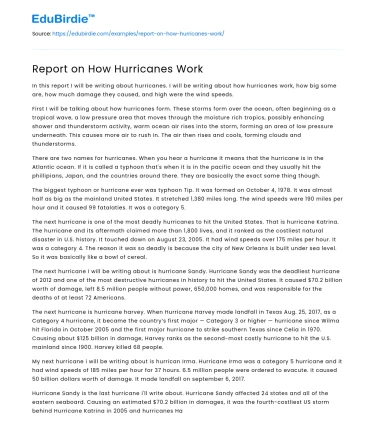Introduction
Hurricanes, also known as tropical cyclones, represent one of nature's most formidable and complex meteorological phenomena. Characterized by their swirling winds, torrential rains, and powerful storm surges, these systems can cause widespread devastation and pose significant challenges to societies worldwide. Understanding how hurricanes work is crucial for developing effective mitigation strategies and improving forecasting methods. This report delves into the intricate workings of hurricanes, examining their formation, structure, and impact. By exploring the scientific principles behind these storms, we can better appreciate the delicate balance of atmospheric conditions that give rise to such formidable forces. Furthermore, this report will address common misconceptions about hurricanes and consider the implications of climate change on their frequency and intensity.
Formation and Development of Hurricanes
The genesis of a hurricane is a complex interplay of atmospheric conditions, primarily occurring over warm ocean waters. The process begins with a cluster of thunderstorms, which, under the right conditions, can organize into a more coherent system. The primary ingredient for hurricane formation is warm ocean water, typically above 26.5 degrees Celsius, which provides the necessary heat and moisture. As the water evaporates, it releases latent heat, warming the surrounding air and causing it to rise. This rising air creates an area of lower pressure at the surface, drawing in more air and fueling the system further.
A crucial aspect of hurricane development is the Coriolis effect, a result of the Earth's rotation, which imparts a spin to the system. This effect is absent along the equator, explaining why hurricanes do not form in equatorial regions. As the system organizes, it develops into a tropical depression, and with further intensification, becomes a tropical storm, eventually reaching hurricane status once sustained winds exceed 119 kilometers per hour. The hurricane's strength and path are influenced by various factors including sea surface temperatures, atmospheric moisture, and existing weather patterns. For instance, the 2005 Atlantic hurricane season, which included Hurricane Katrina, was notably active due to anomalously warm ocean temperatures and favorable atmospheric conditions (NOAA, 2005).
Structure and Dynamics of Hurricanes
A hurricane is composed of several distinct parts, each playing a critical role in its dynamics. At the center lies the eye, a relatively calm region with light winds and clear skies, typically spanning 30 to 60 kilometers in diameter. Surrounding the eye is the eyewall, a ring of intense thunderstorms that harbors the strongest winds and heaviest rains. This eyewall is where the most destructive forces of the hurricane are concentrated, capable of causing severe damage to infrastructure and landscapes.
Spiraling outward from the eyewall are the rainbands, which can extend hundreds of kilometers and contain heavy rain and gusty winds. These bands are responsible for the widespread precipitation associated with hurricanes, often leading to flooding far from the storm's center. A hurricane's intensity and structure are influenced by its access to warm ocean waters and the presence of vertical wind shear, which can disrupt the storm's organization. For example, Hurricane Andrew in 1992 maintained its intensity as it crossed the warm waters of the Gulf of Mexico, while other systems have weakened due to increased wind shear (Landsea et al., 2004).
Impacts and Mitigation Strategies
The impacts of hurricanes extend beyond immediate physical damage, affecting social and economic structures as well. The destructive power of hurricanes is evident in events like Hurricane Maria in 2017, which devastated Puerto Rico, causing loss of life and significant economic disruption (Pasch et al., 2019). The primary hazards associated with hurricanes include wind damage, storm surge, and flooding. Storm surge, the abnormal rise in seawater level driven by the storm's winds, poses a significant threat to coastal communities, often resulting in catastrophic flooding.
Mitigation strategies for hurricanes involve a combination of engineering solutions, policy measures, and community preparedness. Coastal infrastructure can be reinforced to withstand storm surges, while effective early warning systems and evacuation plans are essential to minimize loss of life. Advances in meteorological science have improved the accuracy of hurricane forecasts, allowing more time for preparation and response. However, the increasing prevalence of extreme weather events, potentially exacerbated by climate change, presents an ongoing challenge. Addressing these issues requires a concerted effort from governments, scientists, and communities to enhance resilience and adapt to changing climate conditions.
Conclusion
In conclusion, hurricanes are intricate natural systems that arise from a confluence of atmospheric and oceanic conditions. Understanding their formation, structure, and impacts is essential for mitigating their destructive potential. While significant progress has been made in forecasting and preparedness, the threat posed by hurricanes, particularly in the context of climate change, remains a pressing concern. By advancing our scientific knowledge and implementing robust mitigation strategies, society can better protect itself from the ravages of these powerful storms. As we continue to grapple with the challenges of a changing climate, the importance of research and international cooperation in hurricane science cannot be overstated.






 Stuck on your essay?
Stuck on your essay?

